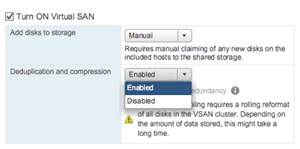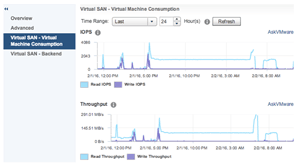In-Depth
A Deep Dive Into VSAN 6.2
Going through the most important features one-by-one.
When VMware Virtual SAN (VSAN) was first released in 2014, I was working as a lab analyst for The Taneja Group and got to spend a fair amount of time working with it. In my analysis of the first iteration of VSAN, I pointed out that it was good product, and could fundamentally change the way a virtualized datacenter consumed storage, but it was missing some key features that would truly make it enterprise ready. I concluded that it was not ready for Tier 1 production enterprise applications, but would be fine in the development lab and for small-scale virtual desktop infrastructure deployments. But as the product matured, and with the release of VSAN 6.2, my list of lacking features that would make it truly enterprise ready just about got wiped out. (For those new to VSAN, it allows computer servers to pool their persistent storage (spinning and flash disks) into a block of shared storage that any node within a vSphere cluster can access.)
A Brief History of VSAN
The second release of the product, announced in February 2015, was VSAN 6. This version included enterprise features such as an all-flash configuration and fault domains; it also provided support for externally-attached storage systems and, for the security conscious, hardware encrypted drives. VSAN 6 also supported vSphere 6 clusters with up to 64 nodes, which equates to 62TB of raw storage. Overall, I felt this was a good evolutionary step, and that non-critical enterprise workloads and larger VDI deployments could be safely used on it.
VMware updated VSAN six months later, in August 2015, with the release of VSAN 6.1. This version removed a few more barriers to enterprise adoption, such as support for stretched clusters, 2-node ROBO configurations, support for NVMe and Ultra DIMM flash devices, five minute recovery point objective (RPO) using vSphere replication, and monitoring with vROPs. This release cemented its use for almost all VDI scenarios as well as some Tier 1 applications.
When VSAN 6.2 was announced last week, it was a blockbuster of a release. This version went even further in removing the barriers to running tier 1 enterprise applications on it. VMware has released a white paper, "What's New: Virtual SAN 6.2," which outlines in detail the new features. (The images in this article have been taken from this paper.)
A quick list of the updated features in VSAN 6.2 is as follows: deduplication, compression, RAID-5/6, storage QOS, software checksum, IPv6 networking, better management and monitoring capabilities, and host memory (RAM) read caching. I'll give a brief overview of each of these features, then some final thoughts.
Deduplication and Compression
Storage arrays, particularly all-flash arrays, have been using deduplication (removing duplicate blocks of information) and compression for years to increase the storage capacity, decreasing the cost per GB of effective storage for an array. VSAN 6.2 has enabled these two technologies only for all-flash VSAN 6.2 arrays.
 [Click on image for larger view.]
Figure 1. Enabling deduplication and compression.
[Click on image for larger view.]
Figure 1. Enabling deduplication and compression.
VMware says that it can reduce storage consumption by as much as seven times. Of course, this estimate is highly dependent on the type of data being held on the array. These features are enabled on a cluster-wide basis with a single drop-down menu selection (see Figure 1). Deduplication uses a 4K block size, and is done in what VMware is describing as a "near-line" fashion. Deduplication and compression can be resource intensive, and VMware is producing other white papers that will give guidance on what workloads will benefit the most from these features.
RAID-5/6
Erasure coding is used in RAID-5/6 configurations on storage arrays, to ensure data integrity with greater storage efficiency than RAID-1 (mirroring). Previous to VSAN 6.2, VSAN only supported RAID-1.
 [Click on image for larger view.]
Figure 2. Enabling the new RAID-5/6 option.
[Click on image for larger view.]
Figure 2. Enabling the new RAID-5/6 option.
By using RAID-5/6, storage consumption can be reduced by as much as 50 percent in comparison to RAID-1, and at the same protection level. VSAN 6.2 allows for this feature to be enabled at the VM or virtual disk level; as before, it's only available on all-flash configurations.
Figure 2 shows the menu to enable RAID-5/6.
Storage QOS
Not all VMs running on a server are equal; some are far more critical than others, and the ability to limit the number of IOPS a storage object can consume is essential in the prioritization of resources. In this release of VSAN, an administrator can limit the number of IOPS an individual components or the entire virtual machine can consume. Figure 3 shows a policy being created that will restrict an object to consume 500 IOPS. I couldn’t find out if this limit will only be honored only if the storage becomes resource constrained.
 [Click on image for larger view.]
Figure 3. Limiting IOPS for a storage object.
Better Management and Monitoring
[Click on image for larger view.]
Figure 3. Limiting IOPS for a storage object.
Better Management and MonitoringVirtual SAN 6.2 includes a bunch of new graphs that break down performance information on the level of the cluster, host, VM and virtual disk. This information can be further customized to show data from the last few hours or from a custom date and time range.
Figure 4 is a screenshot showing the IOPS and throughput for a VM for the last 24 hours.
 [Click on image for larger view.]
Figure 4. A new VSAN 6.2 graph, showing IOPS for a VM.
Host Memory (RAM) Read Caching
[Click on image for larger view.]
Figure 4. A new VSAN 6.2 graph, showing IOPS for a VM.
Host Memory (RAM) Read Caching
With VSAN 6.2 you can enable the host memory (RAM) of a server to be used as a dynamic read cache. This should, in certain situations, provide a huge improvement for VSAN performance. The size of this cache is up to 1GB RAM. I look forward to VMware benchmarking and providing guidance on this feature.
Software ChecksumData integrity is very important, but it's also one of the under-the-hood features you won’t notice or utilize until things go south on you, leaving you wondering why. VSAN 6.2 has implemented a new checksum scheme that performs end-to-end checksums of data, and will detect and silently resolve disk errors to prevent data corruption and storage outages.
IPv6 Networking
At last, VSAN has IPv6 support, including support in mixed mode with IPv4.
One Giant Leap for Software-Defined StorageVSAN 6.2 is a huge leap forward, and puts it in line with the more established software defined storage solutions in the market. Is it missing some features? Yes; I'd like to see VSAN have a long-term support commitment for its HCL, external support for NFS or iSCSI so it can branch out from being vSphere-centric only storage, support for vSphere Virtual Volumes (VVOLs), and a more liberal licensing model that supports storage-only nodes and an even lower RPO for storage objects.
I also look forward to seeing some benchmarking, guidance and third-party validation of features in VSAN 6.2 that may be resource intensive (deduplication, compression, and RAID-5/6), and of those that can give VSAN a performance improvement (RAM read cache and Storage QOS). If the benchmarking and third-party validation prove out, VSAN 6.2 should be ready for many critical Tier 1 applications and all but the most niche VDI implementations.
With all the improvements, I'm surprised that this was a dot release rather than a new version release (VSAN 7), which makes me curious as to what they will be putting into VSAN 7.
About the Author
Tom Fenton has a wealth of hands-on IT experience gained over the past 30 years in a variety of technologies, with the past 20 years focusing on virtualization and storage. He previously worked as a Technical Marketing Manager for ControlUp. He also previously worked at VMware in Staff and Senior level positions. He has also worked as a Senior Validation Engineer with The Taneja Group, where he headed the Validation Service Lab and was instrumental in starting up its vSphere Virtual Volumes practice. He's on X @vDoppler.